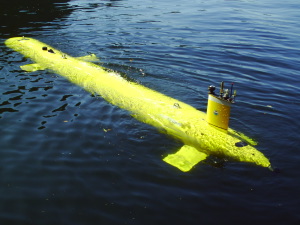
Icy Control
By Treena Hein
General Research Robotics UniversityCanadian-made robotic submarine helps Canada assert arctic sovereignty.

If you felt a surge of national pride during the Olympics, here’s something new to root for: a made-in-Canada engineering marvel battling extreme arctic conditions, all in the name of protecting Canada’s sovereignty.
In mid-March, a small robotic vehicle made by Port Coquitlam, BC- based International Submarine Engineering Ltd. (ISE) was flown up to farthest reaches of north-eastern Canada, reassembled and released through a hole cut in the ice. Using multi- band single-beam sonar, it’s collecting data on the contours of the seafloor, so that a digital terrain model can be created. Canada will use such data to submit a claim to the United Nations over a vast area of arctic territory by a 2013 deadline.
The “Project Cornerstone” sub (and the twin spare) have cost Canadian taxpayers $5 million, a small percentage of the $90 million Canada has dedicated to the claim since 2004. ISE, however, has been in the game of underwater tech much longer than that. Since the mid-1970’s, it’s grown to become a member of an elite group of global high-tech submarine-makers.
ISE has sold more than 250 vehicles in 20 countries, but this project is as challenging as any in the past. GPS can’t be used for navigation because of surface ice, so the sub uses temperature, depth and other sensors – in addition to its all-important programming – to control itself and navigate. “The sub is given a series of mission files with tasks,” says project manager Tristan Crees. “Some are geographic tasks—where it goes to one point and back or moves through a grid of an area—and some are non-geographic tasks, such as controlling payload sensors.”
On Target
The sub is gone for up to four days and 200 km at a time, nerve-wracking for ‘proud poppas’ such as Tristan. “Obviously, the engineering team is more comfortable with short missions and is very concerned with getting the vehicle back,” he smiles. “However, Natural Resources Canada and Defense Research Department Canada need a lot of data, which means taking more risks.”
